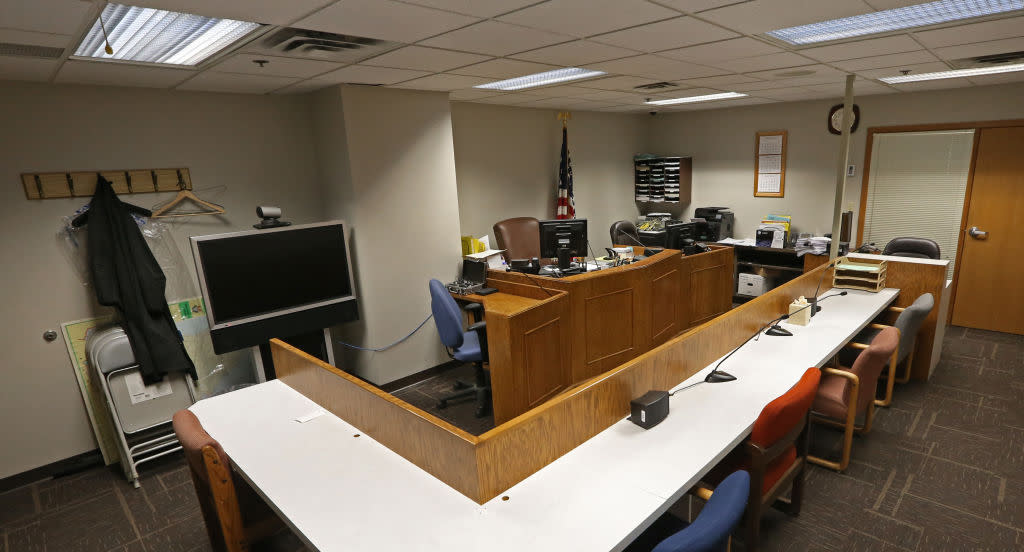A Record-Breaking 1.6 Million People Are Now Mired in U.S. Immigration Court Backlogs

A U.S. Immigration Courtroom in Bloomington, Minn. Credit - Bruce Bisping—Star Tribune/Getty Images
Roughly 1.6 million people are caught up in an ever-expanding backlog in United States immigration court, according to new data tracking cases through December 2021. Those with open immigration cases must now wait for a decision determining their legal status for an average of 58 months—nearly five years.
Though the immigration court backlog has been getting longer for more than a decade, a deluge of new cases added between October and December 2021 significantly worsened wait times, according to the Transactional Records Access Clearinghouse (TRAC), a research institution at Syracuse University that obtained the figures through Freedom of Information Act requests. The backlog increased by nearly 140,000 during that period, the fastest growth on record and the direct result of an uptick in arrests by agencies housed under the Department of Homeland Security (DHS): Immigration and Customs Enforcement (ICE), and Customs and Border Protection (CBP).
“This is an enormous problem that’s facing the country,” says Susan Long, co-director of TRAC and a professor of managerial statistics at Syracuse. “The system is not working well.”
In September, DHS announced it would change its priorities for immigration enforcement, focusing on arresting immigrants that pose a “threat to our national security, public safety, and border security.” But that new directive wasn’t implemented until November 29 and the period just prior saw an extraordinary spike in new arrests. Fewer than 1% of those new cases brought by ICE and CBP beginning in October 2021 involved alleged criminal activity.
COVID-19 has also exacerbated the backlog, as court shutdowns beginning in March 2020 have reduced the number of court hearings and decisions across the country.
DHS declined to comment on the TRAC data. A spokesperson for the Department of Justice’s Executive Office of Immigration Review (EOIR), which oversees the immigration court system, said courts have been relying on technology to continue operations, but blamed the on-going pandemic for the worsening backlog.
More from TIME
A problem more than a decade in the making
In 2009, the U.S. immigration court backlog stood at roughly 200,000 cases. Those with open immigration cases had to wait about 14.5 months for a decision on their legal status, according to TRAC data. Back then, an immigration judge typically presided over 69 hearings a week, according to TRAC.
But in the intervening years, the backlog has gotten steadily longer. One reason is an ever-increasing number of new immigration cases swamping the system, as both the Obama and Trump Administrations issued millions of deportation orders. The number of people claiming asylum has increased by nearly 2,000% between 2008 and 2018.
EOIR has not hired enough new immigration judges to keep pace with this increasing rate of new cases. In 2019, the median caseload for judges was 3,000 annually; some judges took on more than 4,000 cases per year. In Houston, one judge’s caseload exceeded 9,000.
But the problem cannot be solved by asking the existing immigration judges to work harder or faster, Long says. EOIR must hire more judges, expand administrative and IT support staff, and add more courtroom space. To address the immigration court backlog, EOIR will need “gigantically more resources,” she says.
A fundamental rethinking of the system
Addressing the backlog will also require deep systemic changes. While both the Obama and Biden Administrations changed their priorities for immigration enforcement to focus on those with criminal histories, it’s unclear if such reprioritization will impact caseloads overwhelming the courts. Even after the Obama Administration changed its priorities for immigration enforcement, the immigration court backlog continued to grow.
In May 2021, DHS and the Justice Department announced a “dedicated docket” to serve families who crossed into the U.S. between ports of entry on or after May 28, 2021. The new docket promised expedited decision times—a judge in one of 10 cities would decide the case within 300 days of the family’s hearing, according to the announcement.
While the dedicated docket was designed to address the backlog for recently-arrived families, it failed to take into account the staggering systemic failures at work, according to immigration lawyers, advocacy organizations and elected officials. They criticized the new docket as “premised on the faulty assumption that the ten cities selected for this proposal have excess or spare capacity to provide legal representation.” Both the Obama and Trump Administrations also tried but failed to implement similar fast-tracked dockets.
“There’s a long, long laundry list of things that have been tried in the past,” Long says. “It’s not going to be a quick fix.”

